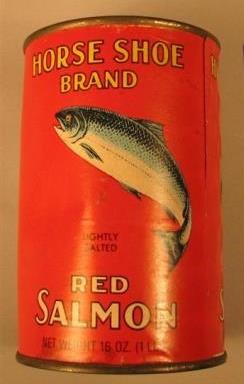
(by Diane Cooper, Museum Technician) What is canned salmon and why should I care? How does one eat canned salmon? Some people I know think a better question is not "how" but "why?" One friend of mine who grew up in the 1950s hated the canned salmon her mother used because it had bits of fish skin and crunchy little bones in it. Another friend of a similar vintage loved that extra crunch those tiny cooked bones gave the salmon dishes her mother made. Personally, I find canned salmon to be delicious--once I've extracted the bits of skin and most of the bones. That, in and of itself, is a tedious and time-consuming job. So, perhaps the real question is, "Why would anyone want to eat canned salmon?" And, perhaps more importantly, "Why do I even ask these questions?" Of course, the reason I bring up the subject of canned salmon relates to artifacts we have in our collection here at San Francisco Maritime National Historical Park. The history of the canned salmon industry is deeply rooted in the San Francisco Bay and its tributaries. The first salmon cannery on the Pacific Coast was founded on the Sacramento River in 1851 by the Hume brothers. In less than 25 years hundreds of small and large canneries dotted the rivers and coastlines of California, Oregon, Washington, British Columbia, and Alaska. These independent canneries eventually incorporated into various larger companies giving them more financial strength and power in the marketplace. The largest and most powerful of those companies was the Alaska Packers Association (APA). Originally formed by 31 canneries that banded together in 1891 to sell off surplus canned salmon, the venture proved extremely successful and beneficial for all the canneries that two years later they incorporated as the Alaska Packers Association. With tens of thousands of cases of canned salmon packed every season, it seems the most compelling question facing the canneries in the newly incorporated Alaska Packers Association should have been something along the lines of, "How do we find more consumers who know what canned salmon is, what to do with it, and want to buy it?" 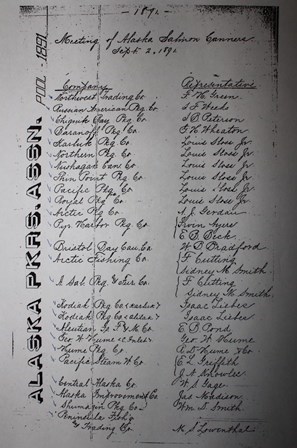
Scan from microfilm in the SF Maritime Research Center At that moment in time the vast majority of the salmon pack went to foreign markets. Although salmon was known along the northeast coast and the west coast, fresh salmon was expensive and considered a delicacy indulged in by the rich. In these areas canned salmon did not rate. Throughout the rest of the United States, Americans were unaware of salmon and its great nutritious value. One of the first, and perhaps only, canneries to think about ways to entice new consumers was the Karluk Packing Company. Incorporated in 1884, Karluk Packing prooduced more than any other cannery in Alaska, averaging 2,600 cases of canned salmon a day and nearly 53,000 cases per season. Karluk Packing was one of the original canneries that joined forces to create the Alaska Packers Association. Despite the fact that APA increased their marketing ability, the men running Karluk Packing continued to look for ways to survive and thrive in the marketplace and within the new corporate structure. They knew they had to find and cultivate loyal consumers interested in their product, Horse Shoe Red Salmon, so, in an attempt to do just that, the Karluk Packing Company addressed the question "how to eat canned salmon" by developing, publishing, and distributing a 36-page cookbook titled, Horse Shoe Red Salmon Cook Book, How To Eat Canned Salmon. The exact years of publication for this first cookbook are uncertain, but the first edition had to appear in or after 1893, the year the Alaska Packers Association, whose logo appears on the back, was officially incorporated and before 1904 when the APA took over the cookbook's publication. Except for the APA logo on the back of this edition's bright red cover, there is no mention of the Alaska Packers or any indication that the APA was involved in this venture. I don't know how Karluk Packing used this cookbook, but I imagine it accompanied the cases of Horse shoe Red Salmon sent to stores where the book could be used to entice new customers into trying the canned salmon and reward loyal consumers who already enjoyed canned salmon with new alternative ways to prepare it. This original publication contained forty recipes, thirty-one illustrations, and some interesting instruction, like "How to Open the Can," within its 3-3/4 by 5-1/4 inch pocket-sized format. 
NPS photo 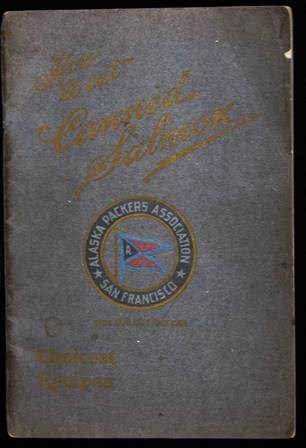
NPS photo
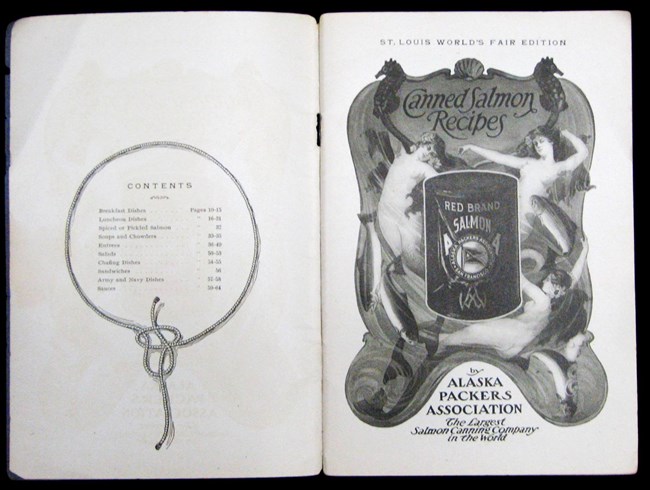
NPS photo Following the 1904 World's Fair, the Packers returned to the smaller original format but retained the black and gold cover for their second edition, How to Eat Canned Salmon, Choicest Recipes, abridged edition. 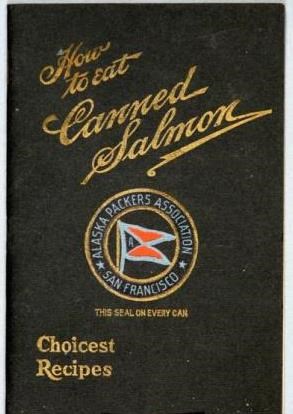
NPS photo A year later, APA would create a new brand, publish a new edition of their cookbook, and embark upon an advertising "experiment" to introduce canned salmon to Americans and turn the country into its newest and, hopefully, biggest market.
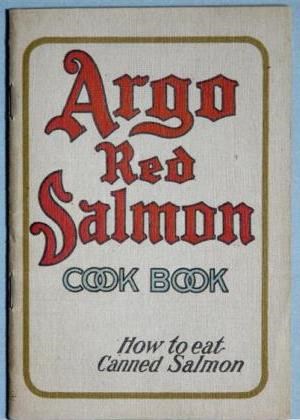
NPS photo "An Introductory and Educational Experiment" Early in 1905, the Alaska Packers Association, "...decided to experiment with a new and distinctive label in order to secure comprehensive data as to the possibilities of increasing the consumption of Alaska Red Salmon by the aid of [an] introductory and educational work." (APA President's Report, 1905, p. 71) Building upon the "introductory and educational" groundwork laid during the St. Louis World's Fair, the Packers chose Mr. H.C. Bliss, the man who had represented them so ably at the St. Louis World's Fair, to run this campaign. Under his leadership, the Alaska Packers Association embarked on an advertising "experiment" to aggressively canvas selected portions of New England, the Midwest, and the South. They created a new and distinctive brand and label, Argo Red Salmon, for the project and chose Wheeling, West Virginia as the first test site. 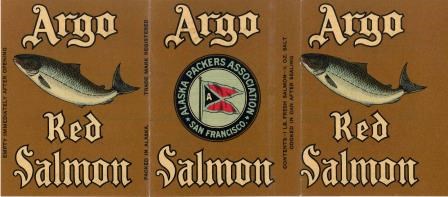
NPS photo Twelve hundred cases of Argo Red Salmon, accompanied by 20,000 advertising labels for Argo canned salmon and a limited number of the remaining World's Fair edition cookbooks arrived in Wheeling in June 1905. By November the experiment had created a strong demand from retailers for canned Argo Red Salmon with 207 out of 225 retailers contacted by canvassers stocking the Argo brand. 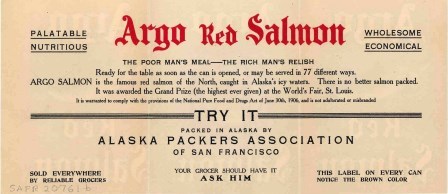
NPS photo The experiment proved so successful that the Alaska Packers immediately published their next edition of this cookbook, renaming it Argo Red Salmon Cook Book, How to Eat Canned Salmon, for use in their new advertising campaign. The 1905 edition of the Argo cookbook, the only edition to ever carry a publication date, was identical to the abridged edition except for the cover and page headers. This edition had a plain beige cover with the book's name in red letters on the front and a can of Argo Red Salmon on the back. The top of each left hand page of the Argo edition still red "Alaska Packers Association" while the top of the right hand pages now read, "Argo Red Salmon Cook Book." 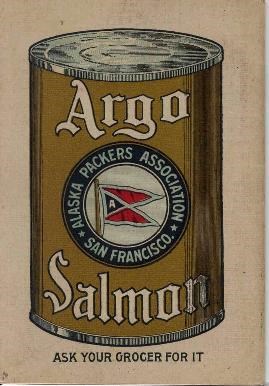
NPS photo By 1907, the cookbook had to be republished with additional pages of text. Opposite the title page, a listing of the "Official Prizes and Awards" received by the APA's red salmon at various expositions and fairs held between 1894and 1905 was inserted. In addition, the introductory section of the Argo edition firmly stated that the Alaska Packers complied with all the provision of the 1906 National Pure Food Act and directed the reader to an essay entitled, "The Art of Canning Salmon, A Concise Statement of the Process as practiced at the Canneries of the Alaska Packers Association" that appeared at the end of the book. These additions were the APA's attempt to counteract the impact which Upton Sinclair's recently published book, The Jungle, an expose of the unhealthy meat processing practices in America, had exerted on the canned salmon industry. 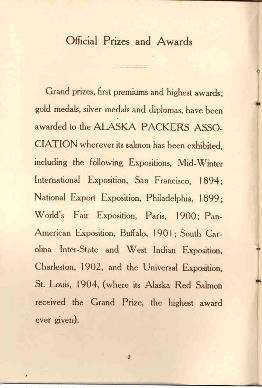
NPS photo And how do I know that the recipes and brand name were passed down from generation to generation? The internet, of course. While looking for information about Argo canned salmon I came upon a forum thread that measured the success of the Alaska Packers' experiment far and beyond their wildest hopes. In January 2007, nearly a century after the experiment ended, 24 individuals shared their childhood memories of eating salmon croquettes made out of canned salmon on an eGullet Society Forum thread. All these people, except one, grew up in the Midwest, southern states, and along the Eastern seaboard. The one exception grew up in Southern Ontario, Canada. Many stated that their parents grew up eating salmon croquettes made from canned salmon. In one of these posts, "Gingersnap" identified the preferred canned salmon, per her mother, as Argo Red Salmon. Gingersnap wrote:
Can you imagine the advertising blitz the APA might have put on if they had known just how far reaching through both time and space their little experiment would be? Wow!
|
Last updated: October 5, 2024
